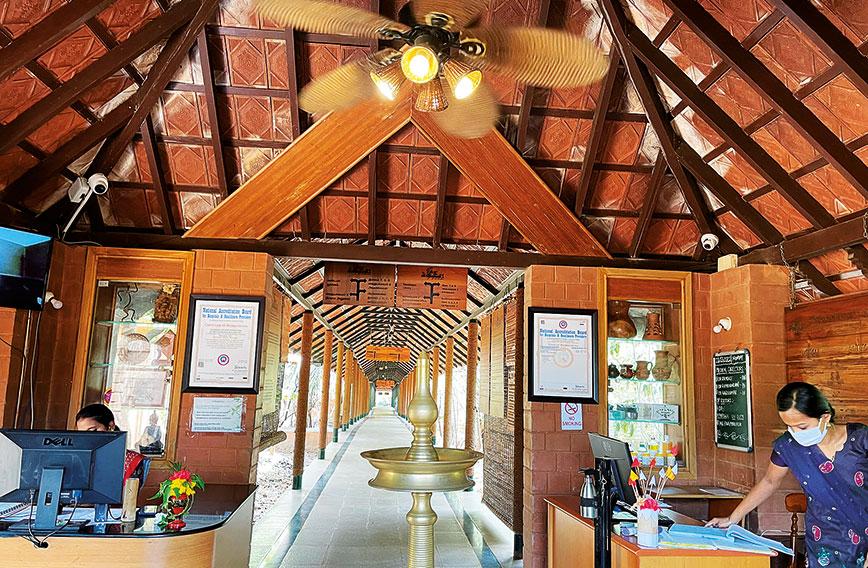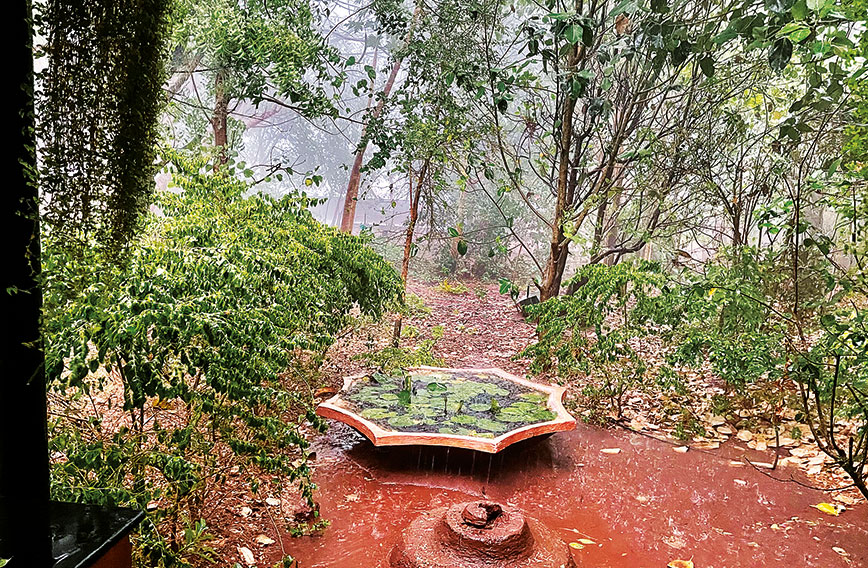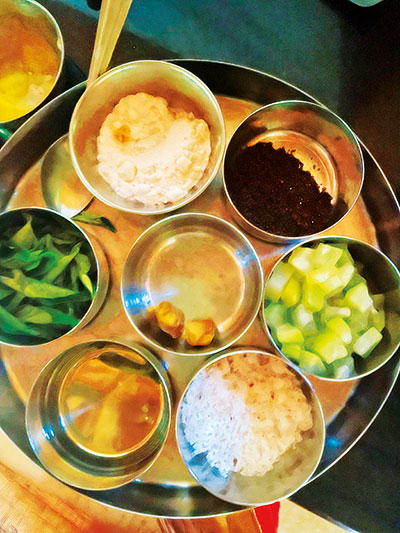
The reception with its covered pathway
Going back to Vaidyagrama for that healing feeling
Jyoti Pande Lavakare
REVISITING the experience of a lifetime is fraught with uncertainties. Will it be as good? Can it be better? What if it is a let-down? So it was with me as I headed back to Vaidyagrama, an idyllic village of vaidyas or Ayurveda physicians nestled among trees in the quietly imposing Nilgiri foothills some 40 km from Coimbatore.
Ten months ago, I had spent 17 days there in search of a cure for my painful tailbone and solace for my wracked spirit after my mother’s death from lung cancer. I left chastened with the learning that solutions in Ayurveda aren’t available over the counter but are coded into your being. I left a ‘new person’ or so I felt. I felt rewired and enhanced.
Now, as I prepared to head back, I hoped fervently that nothing had changed. Vaidyagrama was created in 2008 and has steadily built a reputation for itself as a place to go for treatment or just a reset. Its founders are four third-generation vaidyas: Dr A.R. Ramadas, Dr Ramkumar Kutty, Dr E.K. Ramanandan and Dr K.K. Harikrishnan.
I had found in Vaidyagrama a tranquil island of holistic healing. I prayed that nothing had changed and that the gentle pushback that I received while making my booking — “this is the busy season” — was not an indication of some bigger commercial change having overtaken the place.
Such fears melted away momentarily when Vaidyagrama’s familiar mud-and-brick coloured structure came into view. But wait, what was that new structure opposite its bustling reception? A large, gazebo-like edifice, attached to a familiar covered pathway leading to a spacious hall under a sloping tiled roof — this was new! There were other buildings that looked strangely familiar. Vaidyagrama had expanded, and I couldn’t wait to explore! But first, I needed to meet my vaidya and start my treatment, I reminded myself, turning resolutely towards the reception.
As I settled in, indeed, much had changed. First of all, there were people. Lots of people. From all over the world, many of them non-Indian. They were from Norway, Switzerland, Turkey, Australia, Israel, the UK and, of course, the US. The largest contingent was from Los Angeles — actors, scriptwriters, filmmakers and recording artists.
Hollywood actors such as Nicole Cannon, Linus Roach, Rosalind Bennet sat in a meditative trance during puja. There were Ayurveda vaidyas from the West and authors such as Dr Robert Svoboda, Durga Leela who teaches the Yoga of Recovery, Karla Cain, who is an American Ayurveda and yoga practitioner and Grammy winner Krishna Das aka Jeffrey Kagel.
 And there were writers, many who had authored books from chick-lit to serious non-fiction, books on yoga, addiction and therapies. At first, this demographic felt weirdly glamorous. I wondered how I would deal with celebrities, their egos and the potential distraction at the daily afternoon satsangs — deep discussions from the commonplace and mundane to the divinely spiritual — that I was so looking forward to.
And there were writers, many who had authored books from chick-lit to serious non-fiction, books on yoga, addiction and therapies. At first, this demographic felt weirdly glamorous. I wondered how I would deal with celebrities, their egos and the potential distraction at the daily afternoon satsangs — deep discussions from the commonplace and mundane to the divinely spiritual — that I was so looking forward to.
The demographic had changed. Not just more foreigners, there were more men, more young people and more groups. There was no pressure to mingle. And my room, close to the large, new hall and the old Dhanvantari temple, was a quiet oasis to escape into.
“Pre-Covid, we used to get on average around 60-65 percent foreign patients and 35-40 percent Indian patients. During Covid, almost 85-90 percent were Indian. Post-Covid, the ratio is more even,” said Dr Kutty.
But right now it looked like there were 75 percent foreign patients and 25 percent Indians. Dr Kutty explained that this was due to the international vacation schedules and the gap that Covid restrictions caused — like the revenge tourism that other parts of the country were witnessing. Come March, this ratio would flip, with almost 75 percent of patients from India. But other ratios are also changing.
“We are also getting more male patients than before,” Dr Kutty said, noting that the male to female ratio has changed from 25:75 to 35:65. Younger patients have also increased. “Earlier, we saw patients in the 55 years-plus category, but now we are seeing increasing numbers of 40-plus patients.”
There were several groups too. Like a large group of young Turkish Ayurveda students, a smaller group of older patients recovering from different addictions led by Durga Leela, a charismatic Scottish woman from California, a yoga and Ayurvedic study group called Sattvic Sage led by Karla Cain, a knowledgeable American based out of Arizona and Illinois, and a group of women from Mumbai. Most of the groups congregated through the day even as members took treatment individually.
But even though every corner of Vaidyagrama seemed populated, my fears around this altered demographic turned out to be unfounded.
 The village has a forest and water-harvesting structures
The village has a forest and water-harvesting structures
One reason was that we were a bunch of folks who had actively chosen Vaidyagrama. We were all suffering from some disease or affliction that we hoped to ease, looking for answers, in search of something we didn’t quite understand. This meant that though people looked different, intrinsically we were very similar — in our openness and our approach to this alternative science.
Furthermore, I really didn’t have to explain myself or my culture. Most inmates already knew enough — some of them were chanting arcane Sanskrit slokas in impeccable accents that even I, with a fair knowledge of my religion and culture, didn’t know or remember. In fact, my fear now was that I would inadvertently become part of a commune that was almost cultish in character!
FAMILIAR RHYTHM
By the second week, I realized nothing had really changed in essence. Patients checked out, and new ones checked in. Morning and evening prayers at Vaidyagrama’s energy centre, the Brahmakamalam, took place like clockwork. Treatments were still held in each illam’s treatment rooms on hard wooden tables by gentle therapists with a sense of service. Most things worked on schedule — from the regular appearance of little steel glasses with kashayams in the morning and evening and the large stainless steel tiffin carriers containing breakfast, lunch and dinner, to the efficient cleaning staff, laundry pick-up teams and reception staff. I could see, though, everyone, from the vaidyas to their assistants and the therapists, were stretched to capacity.
The essential culture of Vaidyagrama, of service, holistic healing and of encouraging enquiry and explanations without judgement, seemed unchanged. Dr Kutty is still the visionary brain behind Vaidyagrama. Dr Ramadas is its soul and Drs Ramanandan and Harikrishnan its beating heart and pulsing nerves. Dr Hari Kumar, whose melodious evening pujas transported us to the bhakti path, is akin to its arteries.
These doctors, along with Dr Anupama, the team of bhishaks (senior assistant vaidyas), Dr Vinod and the team of chikistaks along with their gentle, accomplished therapists, are creating an authentic healing village, somewhere between a hospital and an ashram.
There were yellow cranes and trucks I could spot on Vaidyagrama’s periphery, signifying it would grow further. “The next set of illams will be built slightly differently, based on patient feedback and our learnings,” said Dr Kutty. Some would include individual consultation rooms and courtyards as well as an area where larger groups could eat together.
 Currently, everyone is expected to eat quietly, mindfully, in their rooms, except on Wednesdays, when patients congregate for a group lunch. The food is served to them by their doctors and therapists. In addition to second servings and jaggery sweetened desserts, they are encouraged to entertain one another with poetry, songs, readings and even dance which is not allowed if you are going through any intensive treatment. In the new buildings, that may change as groups may want to eat together every day.
Currently, everyone is expected to eat quietly, mindfully, in their rooms, except on Wednesdays, when patients congregate for a group lunch. The food is served to them by their doctors and therapists. In addition to second servings and jaggery sweetened desserts, they are encouraged to entertain one another with poetry, songs, readings and even dance which is not allowed if you are going through any intensive treatment. In the new buildings, that may change as groups may want to eat together every day.
Communities build so quickly at Vaidyagrama that people who prefer to withdraw into themselves find it too “noisy”, Dr Kutty says, his eyes twinkling as I look around in the serene twilight, a peacock’s calls in the distance the only sounds I can hear.
But then I remember the daily evening sessions of music, which had become longer and longer, often lasting beyond the suggested time for turning in — between 9 pm and 10 pm. I remember the size of the group swelling, with more people joining as the music floated through the still night air. I have heard ghazals and umpteen old melodious Bollywood songs punctuated on occasion by a Nordic “troll song”, a Turkish love song, words of a revolutionary poem emotionally performed in English by an Iranian woman, and catchy songs by pop group ABBA.
The new architecture will allow groups to remain together, be communal more compartmentally and peacefully, without disturbing others.
Comments
Currently there are no Comments. Be first to write a comment!



